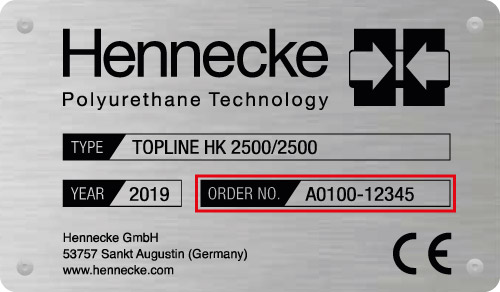At Kaiserslautern University of Applied Sciences, Department of Applied Logistics and Polymer Science, a team led by Prof. Dr. Gregor Grun and Prof. Dr. Sergiy Grishchuk is researching the use of bio-based or recycling-based raw materials in semiindustrial polyurethane processing as part of the international EU project BIOMAT. Hennecke‘s LABFOAM pilot plant is being used for the numerous practical tests.
Sustainable raw materials and the reduction of CO2 emissions in the production of flexible foams and other polyurethane products are becoming increasingly important. Many companies from industry and trade are asking themselves how they can reduce the proportion of petroleum and environmentally harmful blowing agents in their production. This is why BIOMAT was launched in 2021. In the EU-funded project, scientists from eight nations are researching the development of sustainable foams and composites with a high proportion of renewable raw materials. The aim of BIOMAT is to reduce the greenhouse gases produced in the manufacture of foams and composites by 30 to 50 percent and to replace more than half of the material used with renewable raw materials. This research project requires numerous trials with various new raw materials in a wide range of formulations to investigate the respective foaming behavior, durability and other properties of the products. In order to obtain reproducible results and, in particular, to avoid the time-honored “cup tests”, a Hennecke LABFOAM was put into operation at the Pirmasens campus of Kaiserslautern University in 2022. The machine system is the ideal partner for test series and product innovations in the field of polyurethane processing.
Simulation of a large industrial plant
Developing and testing new formulations on a conventional slabstock plant is a resource-intensive undertaking. This is why Hennecke has developed the LABFOAM, which – to put it simply – replicates the reactive part (wet end) of a continuous production plant on a small scale, thus enabling test series with low output quantities. Nevertheless, it achieves results that are almost equivalent in quality to those of a continuous production plant. The high-precision high-pressure metering pumps and the proven Hennecke mixing technology are used. In addition, each individual metering line is designed to process an application-specific range of raw materials, so that an equally wide range of possible test series can be realized. With minimal raw material input, the results of highly scalable industrial production can thus be precisely simulated and tested.
Biopolypols from organic waste
At the Pirmasens Campus, the material properties and potential applications of biopolyols are now being investigated – also on behalf of specific industrial companies. “Biopolyols are preferably obtained from organic waste,” explains Prof. Dr. Gregor Grun. These can be fatty acids, triglycerides, sugars or other suitable organic residues. However, many of these materials are currently still difficult to obtain commercially. A particular challenge in the use of biopolyols is also that they consist of secondary hydroxyl groups and therefore react comparatively slowly. At the same time, attention must be paid to the low flowability of many biopolyols, for which, however, LABFOAM is excellently suited, since it is designed for viscosities of up to 35,000 mPas. In addition to the extraction of biopolyols, research in the polymer department in Pirmasens also includes the synthesization of biopolyesters in order to produce materials that are as compostable as possible or to improve the recycling of polyurethane foams.
LABFOAM – a good choice
There are several good reasons why the university chose the LABFOAM laboratory equipment from Hennecke. Particularly important to the research team were the automation capability, the independent metering lines and the individually adjustable parameters for the up to 25 different raw material components. “Another impressive plus point with the LABFOAM is the patented NOVAFLEX technology for the production of CO2 blown foams. This does away with the need for blowing agents that are harmful to the environment and health – a unique benefit among laboratory equipment,” emphasizes Prof. Dr. Sergiy Grishchuk. At the same time, the system also impresses with its small footprint. The diverse application possibilities find sufficient space on less than ten square meters.
Plant control via FOAMWARE is identical to the operation of continuous production plants. “With just a few clicks, we can create new formulations with a wide variety of components and additives, send them to the machine and start testing,” reports Philipp Haag, a doctoral student on the team and one of the LABFOAM operators. Compared to mixing by hand, this means a significant advantage in terms of accuracy, time savings, raw material consumption and quality of the foam.
65 percent bio-based content already possible
The results of the first year of use are promising. For example, it is already possible to produce flexible foam with a bio-based content of around 65 percent without compromising on quality. “Another crucial aspect of LABFOAM is that it’s not limited to the production of flexible foams,” adds Prof. Sergiy Grishchuk. This is reason enough for the researchers to also investigate the use of organic materials in semi-soft PU foams or in rigid foams, such as those used for insulation in building elements with a sandwich structure. “I can also imagine other types of prepolymers – such as epoxy prepolymers – being processed and studied in the plant,” reports Prof. Sergiy Grishchuk.
The BIOMAT project managers are pleased to be able to train students in the field of polymer chemistry as part of this research and development project and to give them the opportunity to familiarize themselves with industryrelated processes at the plant. This benefits not only the students, but also numerous employers in the polyurethane processing industry, who attach great importance to practical experience.
For Hennecke, too, the transparent exchange of knowledge and information with Kaiserslautern University of Applied Sciences offers important added value, especially with regard to new market requirements relating to sustainable raw material solutions.
















